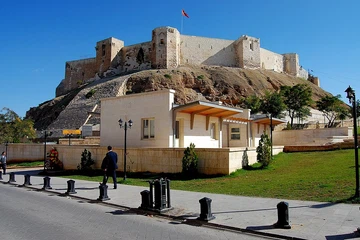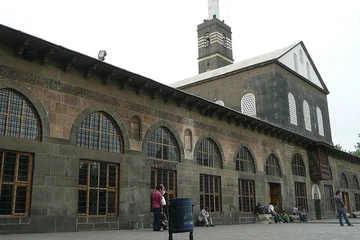Diyarbakır gezi rehberi aracılığıyla dolu dolu bir seyahat planı yapabileceğiniz ve tarihi 9 bin yıl öncesine dayanan Diyarbakır, yüzyıllar boyunca Anadolu ile Mezopotamya arasında bir köprü görevi görmüştür. Bölgede yaşayan insanlar; Hurri, Asur, Urartu, İskit, Medpersan, Akkoyunlu, Makedon, Roma, Sasani, Bizans, Selçuklu, Emevi, Artuklu, Eyyubi, Moğol, Safevi ve Osmanlı devletlerinden kalan kültürel ve tarihi mirası günümüze kadar taşımıştır.
Diyarbakır, 1 milyon 500.000 nüfusu ile Güneydoğu Anadolu'nun en büyük şehridir. Sürekli göçmen alan şehir hızla büyümüştür. Kaplan şehri yendi ve dünyanın en büyük surlarından biri olan Diyarbakır Kalesi şehrin en önemli simgelerinden. Ayrıca şehirde Ulu Cami, Behram Paşa Camii, Hz. Ömer, Mesudiye Medresesi. Meryem Ana Kilisesi ve Atatürk Evi gibi yerleri ziyaret edebilirsiniz. Çin Seddi'nden sonra dünyanın ayakta kalan en büyük kalelerinden biri olan Diyarbakır Kalesi'ne de çıkabilirsiniz.
Diyarbakır karasal iklimden etkilenir. Yazlar çok sıcak ve kurak, ancak kışlar Doğu Anadolu'daki kadar soğuk değil. Havalimanı şehir merkezine yakın. 6 km. Uzak havalimanından şehir merkezine otobüs ve taksi ile ulaşabilirsiniz. Zengin bir mutfak kültürüne sahip olan Diyarbakır'da kaburga dolması, köfte dolması, ciğer kebabı ve kadayıf dolması yiyebilirsiniz. Siz de bu kente seyahat planlamayı düşünüyorsanız; Diyarbakır gezi rehberi yazımızın detaylarını mutlaka inceleyin.
Diyarbakır Ulu Cami
Şehir merkezindeki en büyük Hıristiyan kilisesi olan MarTama Kilisesi, MS 639 yılında Ömer döneminde Diyarbakır ili Müslüman Arapları tarafından camiye çevrilmiştir. Büyük Selçuklu hükümdarı Melikşah tarafından 1091 yılında restore ettirilmiştir. Daha sonra 1115 depremi ve yangınında ağır hasar gören cami, 1240 yılında halkın evlerinden destek alınarak onarılmıştır.
Hazreti Süleyman Cami
Diyarbakır'ın Sur ilçesindeki tarihi camilerden Hz. Süleyman Camii, 1155-1160 yılında Nisanoğlu Ebul Kasım tarafından yaptırılmıştır. Nasiriye Kale Camii ve Murtaza Paşa Camii olarak da bilinen yapı Selçuklu planında, mimarisinde Arap esintileri taşıyor. 1631 - 1633 yılları arasında Silahtar Valisi Murtaza Paşa tarafından cami ve bitişiğindeki Meşhad bölümü restore edilmiştir. Caminin batısındaki harim, şadırvan ve türbe öne çıkanlar arasındadır. Caminin kuzey kesiminde ayrıca türbe ve çeşme bulunmaktadır.
Ziya Gökalp Müze Evi
1806 yılında bazalttan inşa edilen iki katlı bina, 1876 yılında sosyolog Ziya Gökalp'in doğduğu evdir. Ziya Gökalp'in ailesi 1824 yılında bu eve taşınmış ve ölümünden sonra 1956 yılında istek üzerine Turizm Bakanlığı tarafından müzeye dönüştürülmüştür. Ünlü yazarın eşyalarını ve belgelerini içeren ev; Diyarbakır uçak bileti ile pek çok kişi tarafından ziyaret ediliyor.
Evdeki tüm odalar avlunun etrafında yer almaktadır. Diyarbakır evlerinde eyvan havuzlarının güzel örneklerini görebilirsiniz. Her yıl binlerce turisti ağırlayan müze, Diyarbakır etnik grubunun evlerinden yola çıkarak inşa ediliyor.
Hevsel Bahçeleri
Bölgede yaşayan tüm uygarlıkların üretim ve kültürel ihtiyaçlarına özel olarak cevap vererek oluşturduğu bölgede varlığını halen korumaktadır. Diyarbakır Kalesi ve Hevsel Bahçesi kültürel peyzajı sur ve meyve bahçesi olmak üzere iki ana bölümden oluşmakta olup, yedi bin yıllık Diyarbakır Kalesi'nin bahçeleri ile birlikte tarih için önemli bir miras alanıdır. Bahçe kültürünün çok önemli olduğu Diyarbakır, konut bahçesi olarak eşsiz bir değer olarak uzun yıllardır halka açıktır. Diyarbakır Kalesi ve Hevsel Bahçeleri 2015 yılında UNESCO Dünya Kültür Mirası Listesi'ne alınmıştır. Diyarbakır uçak bileti fırsatlarına göz atarak bu noktaya siz de kolayca ulaşabilirsiniz.
Behram Paşa Konağı
Bölgedeki sivil mimarinin en güzel örneklerinden biri olan Behram Paşa'nın konutu doğu ve güney olmak üzere iki bölüme ayrılmış ve iki katlı olarak inşa edilmiştir. Yapımında bazalt kullanılmış ve bir iç avlu, bir eyvan ve avluyu çevreleyen odalardan oluşmaktadır.
Gazi Köşk Şark Evi
Seman Köşkü olarak da bilinen Gazi Köşkü, 15. yüzyılda inşa edilmiş olup Akkoyunlu mimarisinin izlerini taşımaktadır. Çanakkale Savaşı'ndan sonra Atatürk, 1916'da 16. Ordu Komutanı olarak Doğu Cephesi'ne ve Diyarbakır'a atandı. O günden itibaren Atatürk 1917 yılına kadar burada kaldı. Diyarbakır otobüs bileti ile burayı daha yakından görebilirsiniz.
Cemil Paşa Konağı
Cemil Paşa konutu 1887 yılında yapılmış olup Diyarbakır'daki sivil mimari örneklerinden biridir. Geniş bir avlu ve onu çevreleyen yapılarla haremlik ve selamlık olmak üzere iki kısma ayrılmıştır. Göz alıcı mimarisi ile kalker ve kesme taş kullanan tarihi mekanlardan biri haline gelmiştir. İki girişi olan villanın oldukça büyük olduğu söylenebilir. Ayrıca yüzme havuzlu ve kulübeli bir bahçesi vardır. Odalar yaz ve kış olarak ayrılarak misafirhane ve diğer özel odaları kullanırken ziyaretçilere hoş bir his vermektedir. 2014 yılında onarılan konakta; tekstil, seramik, cam, metal gibi birçok obje; Diyarbakır otobüs bileti ile ulaşacak ziyaretçilerini bekliyor.
Diyarbakır Arkeoloji Müzesi
1934 yılında açılan Diyarbakır Arkeoloji Müzesi, 1986 yılında yeni binasına taşınmış ve burada ziyaretçilerini ağırlamaya devam etmektedir. Bu tehcir sırasında Ulu Cami'nin batısında, hükümdar Artukid el-Melikü'nün Salih Mahmud döneminde yaptırdığı Sincariye Medresesi'nde hizmet vermeye devam etti. Müzede; Diyarbakır ve çevresinden Hitit, Asur, Roma, Bizans, Artuklu, Akkoyunlu ve Osmanlı eserlerinin sergilendiği müzede, bölgeden elde edilen Neolitik eserler de sergileniyor. Müzedeki toplam eser sayısı 11 bini aşıyor.
Park Orman
Ayşe Nur Parkorman olarak da bilinen bu park Diyarbakır'ın oksijen ihtiyacını karşılar ve 2007 yılında halkın kullanımına açılmıştır. Parkta 11.000'i birbirinden farklı 57 farklı türde toplam 1553 ağaç, bodur ağaç ve çalı ağaç bulunmaktadır. 900 metre yaya parkı, 250 metre bodhi ağaçlı cadde, 160 metre dişbudak yolu, 110 metre tespih yolu ve 90 metre uzunluğunda çınar ağacı yolu bulunmaktadır.
Anıt Park
Daha önce bakımsız olan ve iki ailenin çay bahçesiyle kaplı olan park, Yenişehir Belediyesi tarafından yürütülen çalışmalarla temiz bir hale dönüştürülmüş ve halkın kullanımına açılmıştır. Parkta; Yayalar için yürüyüş yolları ve oyun alanları da süs havuzları ile dekore edilmiştir. Atatürk anıtı parkın ortasında yer alır ve burada özel gün ve haftalar kutlanır. Diyarbakır nereler gezilir diye düşünüyorsanız, burayı mutlaka gezi planınıza dahil etmelisiniz.
Zülküf Dağı
Ergani halkı tarafından kutsal sayılan Zülküf Dağı iki ayrı bölüme ayrılmıştır. Bunlardan biri Hz. Zülküf'ün makamı, diğeri ise Meryem Ana Kilisesi'dir. Peygamber Zülküf'ün cenazesinin Eğil'de olduğu söylenmektedir, ancak dağda bir koltuğu vardır. Halk arasında oldukça popüler olan bölge, çevre illerden de yoğun ilgi görmektedir. İlkbaharda daha çok ziyaret edilen Zülküf Dağı'na geldiklerinde sık sık yiyecek getirip, dua ederek burayı gezerler. Kur’an-ı Kerim ve mevlidler okunurken, dileklerde bulunulurken, adaklar ve kurbanlar kesilir.
Hasuni Mağaraları
Diyarbakır nereler gezilir sorusuna en sık verilen cevaplardan biri de şüphesiz; Hasuni Mağarası. Silvan'a 7 km uzaklıktaki Hasuni Mağarası, Mezolitik çağda yerleşim yeri olarak kullanılmış ve Anadolu'nun en eski yerleşim mağarası olarak bilinmektedir. Hristiyanlığın yayıldığı ilk günlerde, Antik ve Orta çağ dönemindeki yerleşim yerlerinden biriydi. Yollar, merdivenler, su kemerleri, taş kiliseler, sarnıçlar ve dokuma fabrikaları gibi yerleşimin kültürel ve sosyal ihtiyaçlarını karşılayacak mimari eserlerin yanı sıra Orta Çağ'dan kalma bir kilise de inşa edilmiştir.
Dicle Nehri
Diyarbakır'ın Akçayurt köyünde Kara Çayı ile Aktoprak Çayı'nın kesiştiği yerde doğan dereye Dicle Nehri deniyor. Tarihte pek çok savaş görmüş Mezopotamya'yı oluşturan iki nehirden biri olan Dicle'nin ömrü Basra Körfezi'nde sona eriyor. Ortadoğu'nun yaşam kaynağı olan nehir kuşkusuz Türkiye'de de çok önemli bir nehirdir. Elazığ, Diyarbakır, Batman, Mardin illerinde durur, Türkiye-Suriye sınırına doğru ilerler ve Türkiye-Irak-Suriye sınır üçgeninin bulunduğu noktadan Irak üzerinden geçer. Diyarbakır turistik mekanlar arasında olmazsa olmaz olan bu nehri mutlaka ziyaret etmelisiniz
Çermik Kaplıcaları
Diyarbakır'ın Çermik ilçesinde bulunan Çermik Kaplıcaları, cilt hastalıkları, felç ve romatizmal hastalıklara iyi geldiği biliniyor. Aynı şekilde burada bulunan Belkıs Hamamı da ağırlıklı olarak çocuk sahibi olmak isteyen kadınlara ev sahipliği yapmaktadır. Okudukları özel bir dua ile yıkanan kadınlar çocuk sahibi olacaklarına inanırlar. Çermik kaplıcaları; Sağlık Bakanlığı tarafından test edilmiş ve elemental kükürt ve termal su radyasyonu kalitesine sahiptir. En önemli özelliği suda bromür ve iyodür iyonlarının bulunmasıdır.
Malabadi Köprüsü
Diyarbakır turistik mekanlar arasında son olarak; Malabadi Köprüsü. Diyarbakır'ın tarihi hazinelerinden biri olan Silvan Malabadi Köprüsü, Artukoğulları döneminde 1147 yılında yaptırılmıştır. Selçuklu dönemini yansıtan en önemli mimari ve mühendislik şaheserlerinden biri olan köprü, sivri ana kemerli dünyanın en uzun kemerli taş köprüsü olarak dikkat çekiyor.


